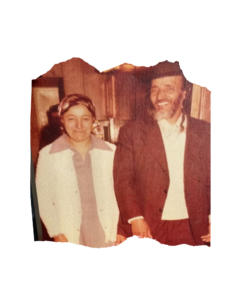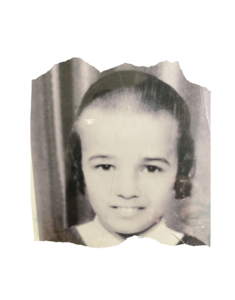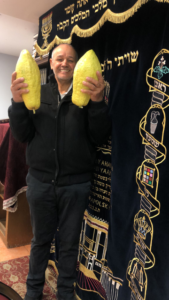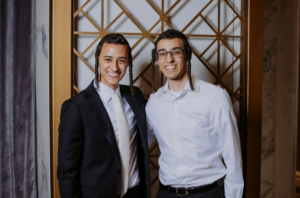Choreographed Tradition
My Yemenite Heritage
Maayan Davis
I run a dance school and a choir for girls. I am a registered nurse and a mother of five. I wear many hats, and yet, what largely shapes me, although it is lesser known, is my rich Yemenite heritage. It’s a unique and cherished part of my identity, and I am eager to share the beauty and uniqueness that my background adds to my life.
Another World
My grandmother, Penina, also known as Bina Shaltiel, was a remarkable woman. I loved hearing stories about her life in Yemen, and she was able to recall stories from as far back as her early childhood. Penina was one of 11 children, born in the city of Shetal in Yemen. Life was hard; three of her brothers and two of her sisters passed away when they were young. But there were also carefree moments that my grandmother recalled happily, such as the mountains of running water she and her siblings used as natural waterslides.
My great-grandmother, Penina’s mother, was Hammame, also known as Yonah in Hebrew. Hammame began her day by gathering firewood. My grandmother loved to tell me about the delicious meals her mother prepared and the warm, bustling atmosphere in her childhood home. Hammame fashioned mats for lulavim, which she sold in the bustling street markets of Shetal. From the age of eight, my grandmother was her constant companion, waking at 4 A.M. to join her at the market, where they stayed until noon.
In my grandmother’s hometown, Jews and Arabs lived side by side. Life was usually quiet, but Arab boys would snatch unmarried Jewish girls. To avoid the problem, there were a lot of arranged marriages, and girls were married at very young ages. My grandmother married my grandfather, Shlomo, at the tender age of 11. They lived separately until they were 15. Within a year Peninah became a mother, welcoming Ezra, and two years later, Miriam, both of whom were born in the city of Suda Diwallla, where they lived after their marriage. My grandfather worked long hours selling dry food, sometimes leaving for days at a time and returning only for Shabbos.
In late 1947, following the United Nations Plan for Partition for Palestine, riots broke out in Yemen, during which 82 Jews were murdered. Just over a year later, my grandparents were among thousands of Jews who fled the country (see sidebar). They traveled with their young children for two full days and then waited a month until they were able to continue their journey on an uncomfortable truck that brought them to the planes that would airlift them to the newly formed state of Israel. The journey was physically and emotionally difficult, but most frightening of all was the attempt of local Arabs to steal baby Miriam late one night. She was already in the arms of her would-be captors when my grandfather awoke, but he managed to chase them and pull her back to safety.
Higher Ground

When they arrived in the newly-formed state of Israel, my grandparents’ first home was a tent. Three children were born in that tent, including my father. Five years passed before Shlomo sought a permanent home, finding a one-bedroom in Herzliya. As their family expanded to nine children, they added a second bedroom.
Shlomo found a job crafting bombs for the army, which required long hours and dangerous conditions. Unfortunately, the toll of the job claimed him at a young age due to exposure to harmful chemicals.
I never met my grandfather, because he passed away before I was born. I was close with my grandmother, however, and spent plenty of time in her home when I was in seminary. The entire extended family gathered in her home for meals. I remember my grandmother working hard, cooking, and singing songs with everyone.
In the backyard of my grandmother’s home was a shul. Its presence was a reminder that no matter where life takes us, the essence of our roots remains firmly grounded – in tefillah and our connection to Hashem.
Colorful Tradition
In Yemen, the primary language spoken was Judeo, a distinct form of Yemeni Arabic that is written with the Hebrew alphabet, easily distinguishable from the local mainstream language.
My grandmother told me that Yemenite Jews sat on the floor instead of on chairs in their shuls. All the Yemenite knew how to read from the Torah perfectly with a precise tune. When it came to kriyas haTorah, each man and boy called up would read his section. Boys began learning Torah when they were as young as three years old, and they learned from early dawn to sunset.
The Jewish girls and women had their own areas of expertise. They were required to have a thorough understanding of the laws concerning kashrus and taharas hamishpacha. Some women even became proficient in the laws of shechitah, taking on the roles of shochtim.

Yemenite Jewish weddings were a sight to behold. The bride wore elaborate jewelry and headpiece, and her clothing was woven with golden threads. Before the wedding, a henna ceremony took place, where a henna paste was applied to the palms of the bride and groom in intricate details.
I grew up eating many traditional Yemenite foods, such as malawach, jachnun, kubaneh, and lechuch. Schug, chelbe, and hawaj flavored many of our family’s dishes, including the famous Yemenite soup. And let’s not forget the delightful zelabia, treat similar to donuts that my mother makes every year during Chanukah.
A Rich and Enduring Legacy
As you all know, I am a dancer, so learning the Yemenite dance was very special to me. Its steps are unique, something worth checking out. I recently saw videos of Yemenite chayalim doing the Yemenite steps, and it was so beautiful to see that the dance is still alive today.
The legacy of my grandparents continues to flourish through the generations. My father, a living embodiment of our heritage, instilled its essence within my brothers. Today, the unmistakable Yemenite payos worn by my brothers stand as a proud testament to our roots.
In my family, our kitchen remains a haven, permeated with the aromas of authentic Yemenite cooking. Each recipe we prepare is testament to the love and dedication we invest in keeping our heritage alive.
Every dish we serve, every minhag we follow, tells the story of our parents and grandparents, and the generations that preceded them in the land from which they were forced to flee. I think of them when I cook, when I dance, when I go through the rhythm of my daily life. Like all Jews, ours is the story of galus. It is the story of a family whose tradition surpasses borders, whose faith and customs cannot be shaken, even if we are forced to move from one land to another. My grandparents were fortunate enough to be able to rebuild their lives in Eretz Yisrael, the true home of every Jew. May it be the will of Hashem that we all return there soon, living as one nation while preserving the traditions that make each of us unique.

Yemen’s Jewish Population
In 1947, there were approximately 63,000 Jews in Yemen. However, the situation took a tragic turn when rioters killed at least 90 Jews in Aden, a southern Yemeni colony. Following the mass tragedy, most of the Yemenite population moved to higher ground, emigrating to the newly established state of Israel during Operation Magic Carpet, which took place from 1949 to 1950. My grandparents joined thousands of their fellow Jews during this covert operation as they were airlifted to safety and away from the country where their roots traced back for many generations. The dwindling Jewish population continued to leave until 1962, when civil war erupted in Yemen. By 1976, only a small Jewish community remained. As of March 2016, the Jewish population in Yemen was estimated at 50 individuals, and by 2022, there was one Jew left in Yemen.

You must be logged in to post a comment.